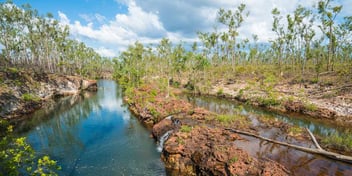Developing a new water plan for the Northern Territory: opportunities and challenges

The Northern Territory’s Strategic Water Plan is currently under development, and the final plan will need to focus on the safety and security of drinking water and be rooted in principles of transparency and community engagement, according to Department of Environment, Parks and Water Security CEO Joanne Townsend.
Speaking at the AWA/WSAA Voices for the Bush Conference in Alice Springs earlier this month, Townsend discussed the development of the plan and said there are some significant changes coming for water in the Territory.
“There are big shifts in water policy for the Territory,” she said.
“There is equal interest raised around matters such as governance, efficiencies, innovation, infrastructure, investment and utilities reform, all of which will need to feature in a draft plan.”
Addressing delegates, Townsend highlighted the questions being raised by the community to bring perspective to the task of formulating a new plan.
The development of the plan heralds a commitment to comprehensively consider policy settings, programs and governance for all aspects of water in the Territory for the the long term, she said.
“It's not possible to talk about water without talking about place in the Northern Territory,” Townsend said.
“Our water shapes and defines the landscapes in the Territory, whether it's the wet, dry tropics of the north that replenish and intersect massive river systems or the arid regions of central Australia, underlaid by groundwater that supports permanent water holes and ecosystems.
“Water is fundamental to the Northern Territory and the importance of a coherent and forward-looking agenda that clearly spells out how water will be managed at the resource level, sustained and shared for the long term, made resilient to the threats of climate change and supplied to meet our needs is a clear and obvious imperative.”
Traditional Owners’ rights
One question facing reformers as they develop the plan is how to incorporate rights bestowed by Native Title and preserve the ability of Traditional Owners to control what happens on their Country.
“Submissions from the land councils are seeking to extend and inform consent requirements for water licence applications across all land tenures, and for this consent to extend to all Aboriginal people potentially affected by the taking of water in connection to that land,” Townsend said.
“This approach is offered as a way to engage with Aboriginal people on water and to recognise the rights and obligations of Aboriginal owners and custodians to land and to water.”
This would require land tenure and water legislation to operate together, Townsend said, and extending procedural rights as they relate to water would also need Federal Government involvement to manage duplication and to support certainty in decision making.
“It will also require a rethink of the Water Act and its foundation tenet of water being property of the Crown,” she said.
“Submitters have called for new water legislation … this call is largely based on concern with the level of discretion in the current Act. The current government has progressed the water reform program, resulting in multiple and significant amendments to that Act — six amendment bills in four years, to be exact.
“These amendments have included a complete overhaul of enforcement and compliance provisions, new requirements for mining and petroleum activities to be subject to that Act, legislating the strategic Aboriginal water reserve to ensure economic access to water for Aboriginal people or those they seek to partner with, and implementing protections to water resources from onshore gas development.”
These amendments have been supported by new regulations, and government policy, Townsend said, which has collectively “shifted the dial” on water management in the Territory.
“A new Water Act is not for the faint hearted and, if it is to be done properly, it is not achievable in the very short term,” she said.
“However, the development of the Strategic Water Plan and its focus, the renewal of the National Water Initiative and the constitution of new national water governance arrangements, as well as strong community interest, provides both the impetus and the policy elements for new legislation for the Territory.
“It also provides a pathway to work together and to establish a shared understanding across all stakeholders on approaches that will work for the Territory and to recognise both the strong cultural and social connections and values of water and the importance of water for our growing economy.”
Access and pricing
One important aspect of water access in the Territory is that, unlike in other parts of the country, water is not apportioned through privately owned licences that function as property rights.
“In the Territory, land and the right to access that land establishes access to water, and it also impacts on how it can be used under provisions of the Northern Territory’s Water Act,” Townsend said.
“Our trading arrangements are limited. All water that is allocated under a licence remains the property of the Crown with the licence, allowing access to use that water on nominated land, under conditions set in the licence — typically that's for 10 years.
“These conditions allow for water that is not being used or impacting other values and uses to be recovered. There is also no charge for water entitlements in the Territory historically, because of the relative availability and in recognition of the infrastructure and operating costs formed by licence holders.”
And this will have implications for pricing, Townsend said.
“The final decision on a pricing regime for all development activities remains to be seen, but the model and approach to any agreed price will need to incentivise water efficiency and recover some of the costs of water management in a way that is equitable, and which supports good social and economic outcomes,” she said.

